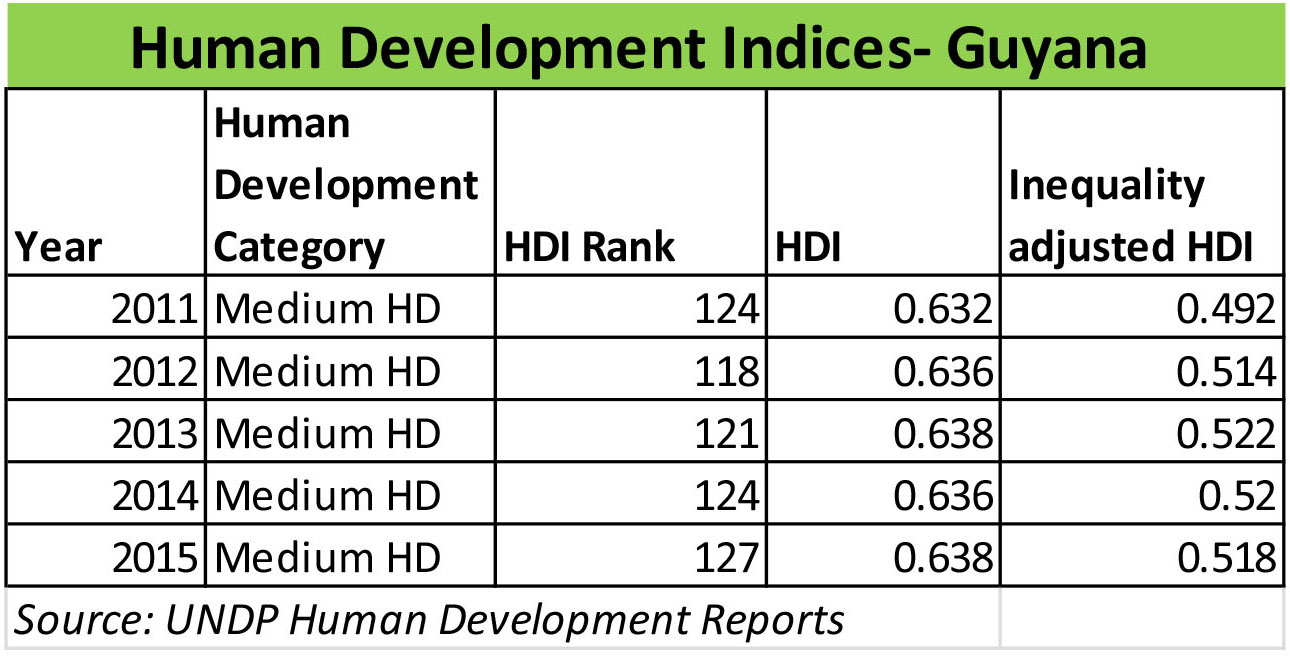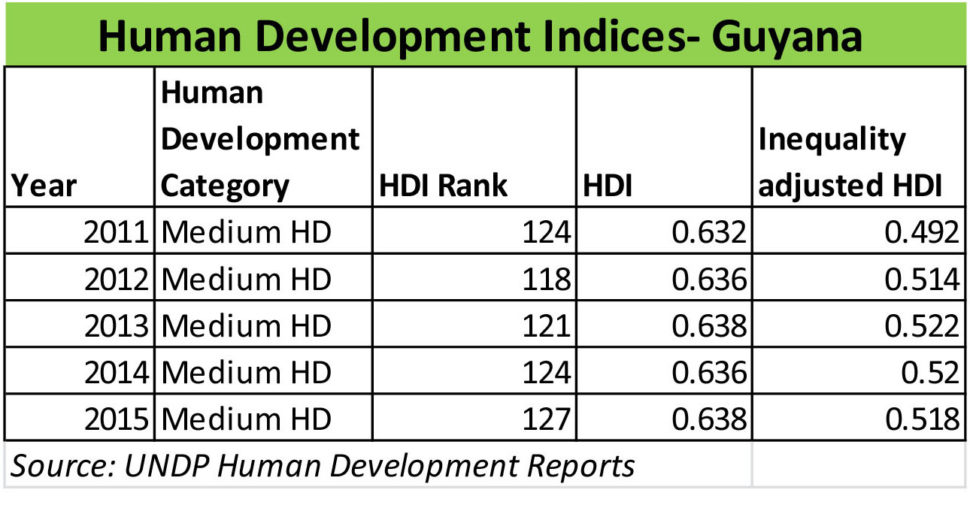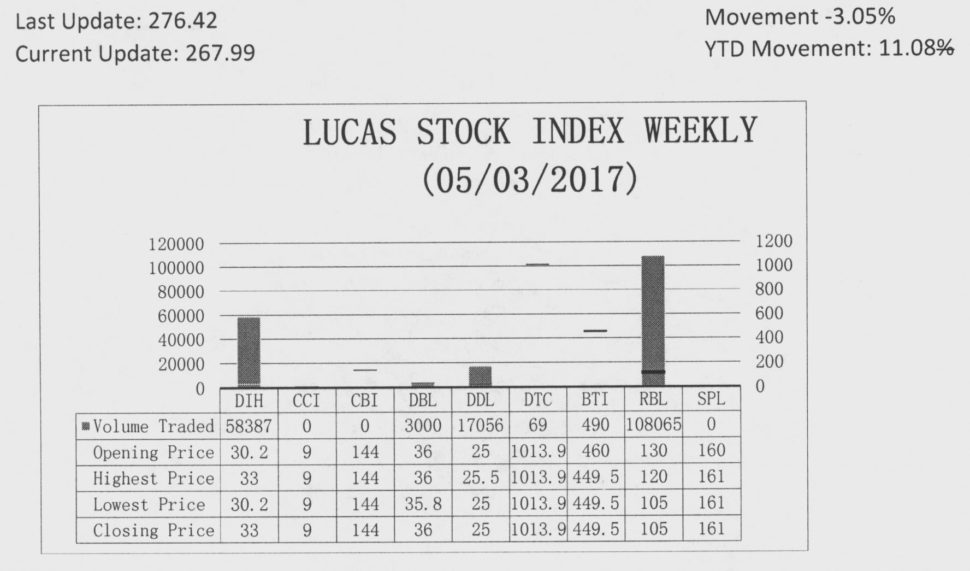Mandate
The United Nations Development Programme (UNDP) is one of the international entities of the United Nations family of organizations. It bills itself as the largest UN agency that specializes in development. UNDP views its mandate currently as providing support to developing countries in designing and implementing national policies for sustainable human development with a focus on poverty reduction. In a world where poverty remains persistent, the efforts of an organization like UNDP must be commended. What UNDP does in a country like Guyana is also significant even though the presence of its personnel in the depressed and impoverished communities is not often conspicuous. With concerns about poverty on its mind every year, UNDP provides a  report on what it thinks is the condition of Guyanese. It is reflected in a number that is referred to as the human development index (HDI). The number is intended to show the economic development of the country. This article discusses the HDI which is usually published by the UNDP to reveal the condition of our lives and that of the other humans on this planet.
report on what it thinks is the condition of Guyanese. It is reflected in a number that is referred to as the human development index (HDI). The number is intended to show the economic development of the country. This article discusses the HDI which is usually published by the UNDP to reveal the condition of our lives and that of the other humans on this planet.
Roles
Ever since 1990 after the first HDI report was launched, UNDP has been publishing the report. No one likes talking about numbers especially when they involve complex calculations. The report is intended to help its readers or users to understand what is happening to people living in this country and other parts of the world. In life, people play many roles. They can be students, consumers, workers, employers and investors. These are not exhaustive or mutually exclusive roles and many people play them simultaneously. But, it must be kept in mind that all roles can contain opportunities and risks. Life is about making use of opportunities that can help people to expand their choices. It is also about giving people the opportunity to change or improve their economic and social circumstances through education and good healthcare. Some others feel that life is also about enjoying freedom of assembly, speech and expression with no restraint imposed on them. There is also the risk of losing one’s job, losing one’s investment, or even losing one’s employee. From that perspective, human development is about people expanding their opportunities, enhancing their capabilities, enlarging their choices and limiting their losses where necessary. That is the way in which UNDP looks at development.
This broad focus which contains the elements of opportunity, capability and choices gives one a chance to assess development differently from the way it was done in the past. The gross domestic product (GDP) was used for a long time by itself to measure economic progress. After some time, it was realized that expanded output did not necessarily change people’s lives. Economic growth is a means to that process, but is not an end by itself. As is often pointed out, it is the richness of people’s lives and not the richness of economies that ultimately is valuable to people. Human progress measured by GDP camouflaged deprivation and poverty as economic wellness. It was not until concerns about the distribution of the wealth arose and the effect that it had on the living conditions and wellbeing of people that people starting rethinking the use of GDP as a measure of development. With such concerns haunting leaders and others, efforts turned to other ways of measuring human progress. Therefore, it was in an environment of dissatisfaction with the human condition and how it was viewed that the Human Development Index (HDI) was born.
Summary Measure
The HDI provides a summary measure of average achievement in a few important dimensions of human development. It looks at how long and healthy life can be. It considers also how knowledgeable people are and have a decent standard of living. The HDI brings the index of each component together using the geometric mean. To a certain extent then, it deals with the rate of change of the three variables collectively. The health dimension is assessed by life expectancy at birth; the education dimension is measured by mean of years of schooling for adults aged 25 years and more and expected years of schooling for children at the time of entering school. The standard of living dimension is measured by gross national income per capita. One thing that the HDI measure tries to do is to reduce the impact that income has on the calculation of the index. The scores for the three HDI dimension indices are then aggregated into a composite index using geometric mean which results are used to rank countries.
The report classifies countries into four categories. The categories are very high human development, high human development, medium human development and low human development. At the top of the list for 2015 in the very high human development category is Norway which has a HDI of 0.949. It is followed by Australia and Switzer-land which has a HDI of 0.939 each. Germany occupies the fourth spot while Denmark and Singapore share the fifth spot. The countries that bring up the rear can all be found in Africa. Burkina Faso ranks 185th, Chad ranks 186th, Niger ranks 187th and the Central African Republic takes the last spot of 188. Guyana falls into the category of medium human development with a rank of 127th out of 188 countries in 2015. This position is a result of slippage in its ranking since Guyana was ranked 124th in 2014, 121st in 2013 and 118th in 2012 as could be seen from the Table below.
TABLE 1
It is interesting to note also that some countries which had experienced prolonged periods of war and internal strife have managed to record a human development index better than Guyana. For example, countries like Iraq and Nicaragua rank far higher than Guyana. It must be pointed out too that the Latin American and Caribbean region is identified as being in the high human development category. However, Guyana along with Paraguay, El Salvador and Bolivia fall outside of the group.
Criticism
Its intentions are good since it is aimed at the people and determining how easy it is for them to obtain the things that they need in life. But even the best of intentions can fall below the expectations of many. As a consequence, some people criticize the HDI for using the wrong variables. To them, the index does not reflect the human development idea accurately. The particular concern is that the index provides an oversimplified view of human development because it is believed to rely on data of low quality. The HDI is a measure of central tendency and causes many to ask if a single number can really tell what life is truly like in Sophia? It does not tell if a person is at risk of committing suicide or if a person was likely to be abused physically or mentally. These are aspects of the human condition which remain unaccounted for in the index.
LUCAS STOCK INDEX
The Lucas Stock Index (LSI) fell 3.05 percent during the first period of trading in May 2017. The stocks of six companies were traded with 187,067 shares changing hands. There was one Climber and two Tumblers. The stocks of Banks DIH (DIH) rose 9.27 percent on the sale of 58,387 shares while the stocks of Guyana Bank for Trade and Industry (BTI) fell 2.28 percent on the sale of 490 shares and that of Republic Bank Limited (RBL) fell 19.23 percent on the sale of 108,065 shares. In the meanwhile, the shares of Demerara Bank Limited (DBL), Demerara Distillers Limited (DDL) and Demerara Tobacco Company (DTC) remained unchanged on the sale of 3,000; 17,056 and 69 shares respectively.











